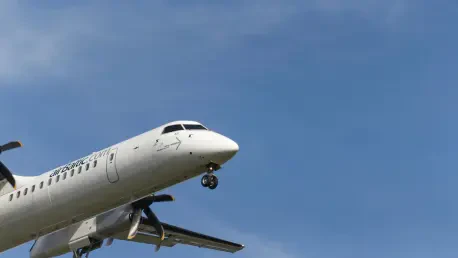Aviation safety is under scrutiny as outdated technological infrastructures threaten passenger safety and operational effectiveness. Recent events have cast a spotlight on the archaic technologies underpinning air traffic control systems, a topic brought to attention by John Oliver’s segment on “Last Week Tonight.” In his critique, Oliver emphasized the antiquated systems still reliant on paper strips and obsolete floppy disks, raising legitimate concerns about aviation integrity and safety. One alarming event that highlighted these worries occurred at San Francisco International Airport, where two jets narrowly avoided a collision, underscoring the dire consequences that could arise from outdated systems. The implications of these aged technologies have prompted conversation, shedding light on the $5.3 billion backlog in facility components deemed essential across the country’s aviation infrastructure. This situation has forced the Federal Aviation Administration (FAA) to source spare parts from eBay, as these components are no longer manufactured, presenting a worrying scenario for aviation safety.
Outdated Systems Impacting Aviation Safety
Legacy Infrastructure Challenges
The current state of aviation infrastructure reveals a landscape plagued by obsolete technology unable to meet the demands of modern air travel efficiently. The persistence of paper strips in a digital age, alongside the aggressive search for discontinued parts on online platforms, amplifies the critical need for overhauling an outdated system. This antiquated approach can lead to severe bottlenecks and inefficiencies, contributing to the operational challenges faced across various airports. Newark Liberty Airport vividly illustrates these challenges, experiencing frequent delays and cancellations attributed to persistent air traffic control staffing shortages and radar outages, further exacerbating the situation. These persistent issues highlight a distressing trend that not only disrupts airport operations but also poses significant risks to passenger safety, demanding immediate attention and intervention.
Technological inadequacies within the aviation sector present heightened risks and underscore the urgent need for upgrading industry infrastructure. The systems currently in use are often unable to effectively handle the vast amounts of data and real-time communication necessary for seamless air traffic management. Additionally, reliance on outdated systems makes it increasingly difficult to integrate new technologies that could enhance operational efficiency and safety. With jetliners flying at higher frequencies and volumes than ever before, the discrepancy between existing infrastructure capabilities and current demands becomes glaringly apparent. As air travel continues to grow, there remains an escalating need to equip systems with the digital capabilities necessary for both processing speed and accuracy, ensuring the safe separation of aircraft and reducing the risks of accidents.
Calls for Legislative Support and Reforms
In response to the urgent need for modernized air traffic control infrastructure, there is a rising consensus among aviation professionals and policymakers for comprehensive reforms. Transportation Secretary Sean Duffy has been a prominent advocate for these reforms, underlining the critical importance of initiating costly overhauls to the current air traffic control systems. These reforms aim to integrate cutting-edge digital technologies, streamline operations, and enhance safety measures throughout the aviation sector. By championing these enhanced digital capabilities, the goal is to prevent further incidents similar to those that have caused concerns at major airports like Newark.
The advocacy for legislative support primarily involves persuading legislators of the urgent need for significant investments in aviation technology. Funding these upgrades is imperative to replace outdated systems with designs capable of accommodating the complex needs of contemporary air travel while simultaneously addressing security threats. This advocacy encompasses securing appropriate funding and enacting policies needed to drive modernization and implement cutting-edge systems. The combined efforts of policymakers and industry leaders convey a clear message of the critical need for transformation, pursuing resolutions and policies that decisively address existing gaps and reinforce safety protocols.
The Imperative for Swift Action
Modernization as a Pivotal Moment
The consensus on the need for overhauling aviation technology marks a pivotal moment for the United States aviation industry, signifying both a challenge and an opportunity for advancements. As air travel safety remains a top priority, these planned modernizations are championed as necessary actions that must be mobilized promptly. The urgency to transition from outdated systems to modern infrastructures is palpable, propelling industry and government stakeholders to consistently underscore its significance. Modernization is not just a concern for air traffic experts; it also represents a vital component in maintaining public confidence in aviation safety.
With potential benefits extending beyond safety to include operational efficiencies and cost reductions, the advantages of modernization are numerous and compelling. Despite the initial financial outlay, these upgrades are envisioned to produce a tangible long-term return on investment, optimizing air traffic management. Consequently, timely implementation of modernization efforts can significantly enhance aviation operations, potentially serving as a framework for other nations to emulate. Awareness of this pivotal moment amplifies the emphasis on executing these initiatives thoroughly, ensuring the sector evolves to meet contemporary challenges.
The Future of Aviation Is Now
Aviation safety has come under the microscope as technology infrastructures age and show inefficiency, posing risks to both passenger safety and operational efficacy. Recent incidents have spotlighted the outdated systems supporting air traffic control, highlighted by John Oliver’s “Last Week Tonight” segment. Oliver stressed that these systems still use paper strips and old floppy disks, sparking valid concerns over aviation integrity. An alarming instance at San Francisco International Airport, where two aircraft narrowly missed a collision, exemplified the possibly catastrophic outcomes of these antiquated systems. Such events have ignited discussions, revealing a $5.3 billion backlog in crucial facility components across the nation’s aviation setup. This has compelled the FAA to turn to eBay for spare parts no longer in production, painting a troubling picture for aviation safety. The urgency for modernizing these infrastructures is evident, as failure to do so could compromise passenger safety and overall aviation reliability.









